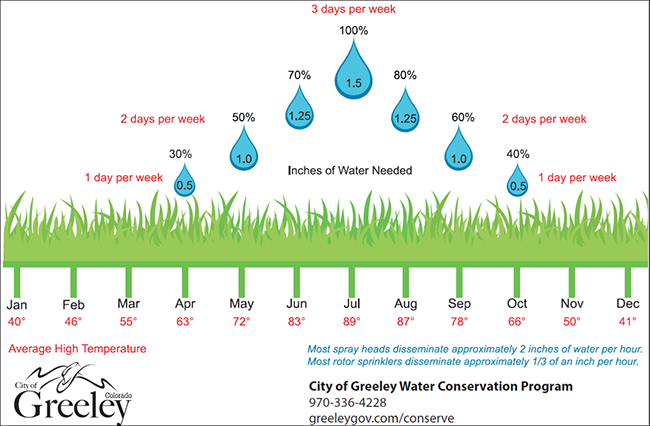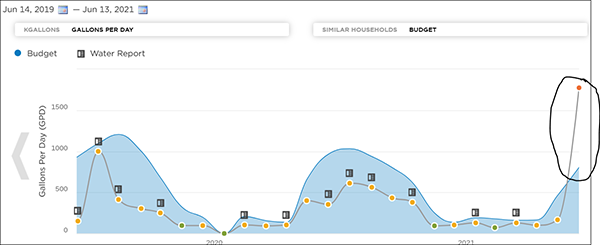Your water budget is not only set for the number of people in your household, the size of your yard and the weather. So you are going to have a bigger budget in July than you will in June and August. The city allows an ample water budget for your yard, but sometimes, if you overwater to compensate for the heat, you will go over your water budget. See diagram below. Remember that bluegrass is a cool season turf and has evolved to go dormant during times of stress –like 100 degree weather.

This graphic shows the bell curve of the Irrigation Water Requirement with the number of suggested days/week to water throughout the season or the percentage to set on your sprinkler clock.
With the city’s new meters – which will start to be installed this month -- you will be able to monitor your use better than ever before. The meters are set up to relay information to your WaterSmart portal in real time, so you know when your usage is approaching your limits. You also can set alerts on your on the WaterSmart portal to alert you when you’re about to go over your Water Budget. You cab even set leak or use alerts while you’re away.

The sharp up turn in consumption indicates a leak or valve that was left open.
Meanwhile, try some of these tips to make your summer watering into a water-conservation model.
- Pay attention to your water budget and water use. Look at your bill monthly.
- Water only what you need to cut down on waste. (misting, run off and pooling)
- Don’t over-fertilize your lawn. Fertilizer makes your lawn need more water. Only fertilize in the spring and summer – not during the heat of the summer.
- Get a free sprinkler system audit. Irrigation Audit
- Consider replacing some of your turf with low-water xeric plantings, natives or native grass.
- Use your test cycle on your sprinkler clock and do a walk-through of your system weekly or at least monthly, checking for leaks, misdirected or broken heads.
- Install a smart controller that adjusts the schedule to the weather.
- Apply the water low and slow.
- Use cycle and soak to make the best use of your water. Cycle and Soak.
- Hand-water brown spots rather than adding time your clock.
- Install a rain sensor to shut your system off if it rains.
- Don’t water when it is windy or during the heat of the day.
- Find, flag and fix leaks.
- Set your clock for July as 100% and use the percent button on your clock to adjust the rest of the season. Use this graphic as a reference on your water use.
- Don’t forget to start turning your system down later in August. While we still get some 90-degree days, it isn’t 90 degrees all day and the Irrigation Water Requirement goes down. Set a reminder on your calendar or some visual or auditory clue like when you start to see school busses again or when tie cicadas start to hum.
- Take advantage of fall planting when temperatures are cool, but the soil is still warm. Then your trees, shrubs and perennials will be acclimated and ready to face the next growing season with less water.
- Don’t cut your grass too short; let it grow longer during the warmest months. Longer grass shades the soil and helps it retain water. Never cut more than one-third off at a time.
- Core-aerate in spring and fall and top dress with compost to add organic material back into the soil.
- Wash your car at the car wash; it not only uses less water than washing at home, you prevent car grease, oil, debris and detergent from going down the storm drain. Choose a car wash that recycles their water.
- Install a rain gauge to keep track of your precipitation and deduct it from what your water needs for that week. By monitoring the weather, you can get a better feel for what your landscape needs when watering.